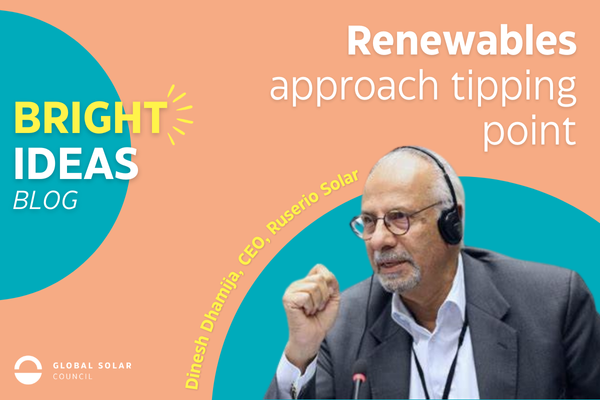Bright Ideas Blog
Ruserio Solar CEO Dinesh Dhamija: Renewables approach tipping point

The Bright Ideas Blog is a series of articles providing new perspectives, ideas, and innovations from thought leaders in the global solar sector. We highlight the insights from our global community of members on a variety of topics relevant to the solar sector in every corner of the world.
A dramatic surge in solar energy generation amid falling costs - and a sudden Chinese enthusiasm for the sector - means that clean energy investment will be twice that of fossil fuels in 2024, according to the International Energy Agency (IEA).
“For every dollar going to fossil fuels today, almost two dollars are invested in clean energy,” said IEA executive director Fatih Birol. The total figures are $1 trillion for fossil fuels versus $2 trillion for clean energy, made up of renewables, nuclear power, electric vehicles, power grids, energy storage, low-emissions fuels, and energy improvements.
The cost of solar technology has fallen by 30 percent in the past two years, spurring the rapid construction of solar farms across China and the United States, where almost 8GW of solar energy capacity came onstream in the first four months of 2024, alongside 1.8GW of wind energy generating capacity.
More than 99 percent of new US generating capacity between January and April this year came from renewable sources, said the Federal Energy Regulatory Commission. As costs continue to plummet, we can expect this pattern to intensify. Much as the oil and gas (and coal) industry attempts to argue that hydrocarbons need to be part of the long-term energy mix, the economics of power generation are becoming so lopsided that no government is going to hold out for long. Why would you pay more – often much more – for an energy source that is also causing so much local pollution?
Global investment in low-carbon electricity is expected to reach $900 billion in 2024, ten times higher than investment in gas and coal power generation. In the United States, renewable energy capacity is expected to overtake that of natural gas by 2027. Once this happens, citizens will become aware whether they live in a country which clings to fossil fuel generation, costing them money and health, or whether they benefit from a more enlightened administration.
The IEA bemoans the fact that investment in fossil fuels remains higher than it would like, with oil and gas companies putting just 4 percent of their investment budgets into clean energy, while ‘claiming to be part of the solution.’ The agency wants governments to stick to its target of tripling renewable energy generation by 2030. Of course, there is always more that can be done. But I believe the undeniable, irrepressible, and accelerating tide of funds into renewable energy has reached a tipping point.
Soon, it will seem ridiculous to do anything else.
About the author
Dinesh Dhamija is a former Member of the European Parliament and CEO of Ruserio Solar, a member of the Global Solar Council. He has created the largest solar PV and hydrogen businesses in Romania. He runs a blog where he shares his reflections on the solar industry for the Global Solar Council. Dinesh's latest book is The Indian Century - buy it from Amazon at https://www.amazon.co.uk/dp/1738441407/
The views expressed in this article are those of the author alone and not of the Global Solar Council.
![Global Solar Council [logo]](/static/images/gsc-logo-horizontal.svg)